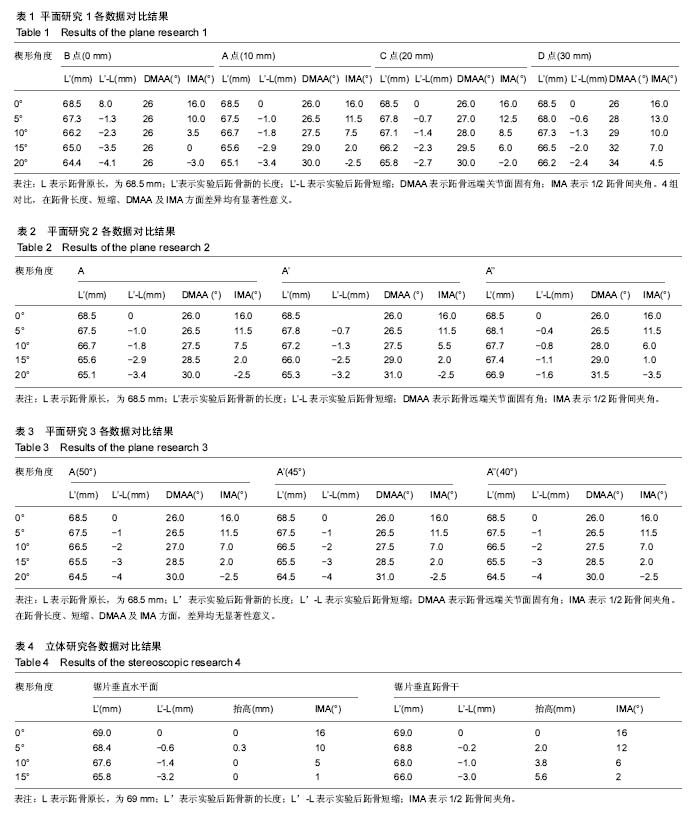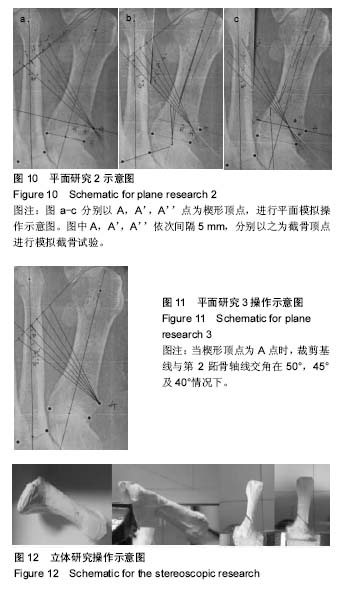| [1] Scranton PE Jr.Principles in bunion surgery.J Bone Joint Surg Am. 1983;65(7): 1026-1028.[2] Peterson DA, Zilberfarb JL, Greene MA, et al. Avascular necrosis of the first metatarsal head: incidence in distal osteotomy combined with lateral soft tissue release. Foot Ankle Int. 1994;15(2):59-63.[3] Mann RA,Rudicel S,Graves SC. Repair of hallux valgus with a distal soft-tissue procedure and proximal metatarsalosteotomy. A long-term follow-up.J Bone Joint Surg Am. 1992;74(1):124-129.[4] Coughlin MJ, Grimes S. Proximal metatarsal osteotomy and distal soft tissue reconstruction as treatment for hallux valgus deformity.Keio J Med. 2005;54(2): 60-65.[5] Zettl R, Trnka HJ, Easley M, et al. Moderate to severe hallux valgus deformity: correction with proximal crescentic osteotomy and distal soft-tissue release. Arch Orthop Trauma Surg .2000;120(7): 397-402.[6] Coughlin MJ, Mann RA. Hallux valgus. Surgery of the footand ankle. vol 1, 8th edn. Mosby.1999.[7] Easley ME, Trnka HJ. Current concepts review: halluxvalgus part II: operative treatment. Foot Ankle Int.2007;28(6):748-758.[8] Jahss MH, Troy AI, Kummer FJ. Roentgenographic and mathematical analysis of first metatarsal osteotomies for metatarsus primus varus: a comparative study. Foot Ankle.1985;5:280-321.[9] Kummer FJ. Mathematical analysis of first metatarsal osteotomies. Foot Ankle. 1989;9:281-289.[10] Kummer FJ, Jahss MH. Mathematical analysis of foot and ankle osteotomies. In: Jahss M; editor. Disorders of the foot and ankle: medical and surgical Management. Philadelphia: WB Saunders, 1991:541-563.[11] Palmanovich E, Myerson MS. Correction of moderate and severe hallux valgus deformity witha distal metatarsal osteotomy using anintramedullary plate. Foot Ankle Clin. 2014;19(2):191-201.[12] Park YB, Lee KB, Kim SK, et al. Comparison of distal soft-tissue procedures combined with a distal chevron osteotomy for moderate to severehallux valgus: first web-space versus transarticular approach. J Bone Joint Surg Am. 2013;95(21):e158.[13] Bai LB, Lee KB, Seo CY, et al. Distal chevron osteotomy with distal soft tissue procedure for moderate to severe hallux valgus deformity. Foot Ankle Int. 2010;31(8):683-688.[14] Fakoor M, Sarafan N, Mohammadhoseini P, et al. Comparison of clinical outcomes of scarf and chevron osteotomies and the McBride procedure in the treatment of hallux valgus deformity. Arch Bone Jt Surg. 2014; 2(1): 31-36.[15] Easley ME, Trnka HJ. Current concepts review: hallux valgus part 1: pathomechanics, clinical assessment, and nonoperative management. Foot Ankle Int.2007;28(5):654-659. [16] Lucijanic I, Bicanic G, Sonicki Z, et al. Treatment of hallux valgus with three-dimensional modification ofMitchell’s osteotomy: technique and results. J Am Podiatr Med.2009;.99(2):162-172.[17] Robinson AH, Bhatia M, Eaton C, et al. Prospectivecomparative study of the scarf and Ludloff osteotomies in thetreatment of hallux valgus. Foot Ankle Int.2009;31(10):955-963.[18] Saragas NP. Proximal opening-wedge osteotomy of the firstmetatarsal for hallux valgus using a low profile plate. Foot Ankle Int.2009;30(10): 967-980.[19] Adam SP, Choung SC, Gu Y, et al.Outcomes afterscarf osteotomy for treatment of adult hallux valgus deformity.Clin Orthop Relat Res. 2011; 469(3):854-859.[20] Kinnard P, Gordon D. A comparison between Chevron and Mitchell osteotomies for hallux valgus. Foot Ankle. 1984;4(5):241-243.[21] Loison M. Note sur le traitment chirurgical de hallux valgus d’apres l’etude radiographique de la deformation. Bull Mem Soc Chir. 1901; 27:528.[22] Balacescu J. Un caz de hallux balgus simetric. Rev Cir.1903;7:128.[23] Curda GA, Sorto LA.The McBride bunionectomy with closing abductory wedge osteotomy: a postoperative review. J Am Podiatry Assoc. 1981;71(7):349-355.[24] Graziano TA. Proximal closing wedge osteotomy and adductor tenotomy for treatment of hallux valgus.Foot Ankle. 1989;10(3):191.[25] Resch S, Stenström A, Egund N. Proximal closing wedge osteotomy and adductor tenotomy for treatment of hallux valgus.Foot Ankle. 1989; 9(6):272-280.[26] Toepp FC, Salcedo M. First metatarsal closing base wedge osteotomy using real-time fluoroscopy. Clin Podiatr Med Surg. 1991;8(1):137-151.[27] Christenson C, Jones RO, Basque M, et al. Comparison of oblique closing base wedge osteotomies of the first metatarsal: stripping versus nonstripping of the periosteum. J Foot Surg. 1991;30(2): 107-113.[28] Nigro JS, Greger GM, Catanzariti AR. Closing base wedge osteotomy. J Foot Surg. 1991;30(5):494-505.[29] Coughlin MJ, Carlson RE. Treatment of hallux valgus with an increased distal metatarsal articular angle: evaluation of double and triple first ray osteotomies. Foot Ankle Int. 1999;20(12):762-770.[30] Wagner E, Ortiz C, Gould JS, et al. Proximal oblique sliding closing wedge osteotomy for hallux valgus. Foot Ankle Int. 2013;34(11): 1493-500.[31] Yano K, Ikari K, Iwamoto T, et al. Proximal rotational closing-wedge osteotomy of the first metatarsal in rheumatoid arthritis: clinical and radiographic evaluation of a continuous series of 35 cases. Mod Rheumatol. 2013;23(5):953-958[32] Day T, Charlton TP, Thordarson DB. First metatarsal length change after basilar closing wedge osteotomy for hallux valgus.Foot Ankle Int. 2011;32(5):S513-518.[33] Nedopil A, Rudert M, Gradinger R, et al.Closed wedge osteotomy in 66 patients for the treatment of moderate to severe hallux valgus.Foot Ankle Surg. 2010;16(1): 9-14.[34] John M, Schuberth DPM. The closing base wedge osteotomy for severe hallux valgus.Tech Foot Ankle Surg.2007;6(3):175-184. [35] Neese DJ, Zelichowski JE, Patton GW. Mau osteotomy: an alternative procedure tothe closing abductory base wedge osteotomy.JFoot Surg. 1989;28(4):352-362.[36] Martin DE, Blitch EL. Alternatives to the closing base wedge osteotomy. Clin Podiatr Med Surg. 1996;13(3):515-531.[37] Trnka HJ, Mühlbauer M. Basal closing wedge osteotomy for correction of hallux valgus and metatarsus primus varus: 10- to 22-year follow-up. Foot Ankle Int. 1999;20(3):171-177.[38] Zembsch A, Trnka HJ, Ritschl P. Correction of hallux valgus. Metatarsal osteotomy versus excision arthroplasty. Clin Orthop Relat Res. 2000;(376):183-194.[39] Nyska M, Trnka HJ, Parks BG, et al. Proximal metatarsal osteotomies: A comparative geometric analysis conducted on sawbone models. Foot Ankle Int. 2002;23:938-945.[40] Palladino SJ. Orientation of the first metatarsal base wedge osteotomy: perpendicular to the metatarsal versus weight-bearingsurface.J Foot Surg. 1988;27(4):294-298.[41] Wolke B, Sparmann M.Results after distal Austin and proximal displacement osteotomy: therapy for hallux valgus.Foot Ankle Surg. 1999;5(1):47-52.[42] Denim F, Rees S, Tagoe M. A radiographic evaluation of oblique closing base wedge osteotomies for correction of hallux abductus valgus. Foot. 1998;8:33-37.[43] Easley ME, Darwish HH. Hallux Valgus: Proximal first metatarsal osteotomies. Int Adv Foot Ankle Surg. 2012; 11-25.[44] Fillinger EB, McGuire JW, Hesse DF, et al. Inherent stability of proximal first metatarsal osteotomies: a comparative analysis. J Foot Ankle Surg. 1998;37: 292-302.[45] Trnka HJ, Parks BG, Ivanic G, et al. Six first metatarsal shaft osteotomies: mechanical and immobilization comparisons. Clin Orthop Relat Res. 2000;(381):256-265.[46] Haas Z, Hamilton G, Sundstrom D, et al. Maintenance of correction of first metatarsal closing base wedge osteotomies versus modified lapidus arthrodesis for moderate to severe hallux valgus deformity.J Foot Ankle Surg. 2007;46(5):358-365.[47] Haendel C, Lindholm JA. First metatarsal wedge osteotomies:a retrospective study. JAPA. 1982;72: 550.[48] Denton J, Kuwada GT.Retrospective study of closing wedge osteotomy complications at the base of the first metatarsal with bone screw fixation. J Foot Surg. 1983;22:314.[49] Zlotoff H. Shortening of the first metatarsal following osteotomy and its clinical significance. JAPA.1977;67: 412.[50] Jeremin PJ, Devincentis A, Goller W. Closing base wedge osteotomy: an evaluation of twenty-four cases. J Foot Surg. 1982;21: 316.[51] Schuberth JM, Reilly CH, Gudas CJ. The closing wedge osteotomy: a critical analysis of first metatarsal elevation.JAPA.1984;74:13.[52] Nigro JS, Greger GM, Catanzariti AR. Closing base wedge osteotomy. J Foot Surg. 1991;30: 494.[53] Ruch JA. “First Metatarsal Osteotomies in the Treatment of Hallux Abducto Valgus: Rigi Internal Fixation Techniques-Results and Complications,” in Doctors Hospital Podiatric Education and Research Institute Seminar Manual, ed by ED McGlamry, The Podiatry Institute, Tucker, GA, 1982.[54] Kummer FJ. Mathematical analysis of first metatarsal osteotomies. Foot Ankle.1989;9: 281.[55] Banks AS, Cargill RS 2nd, Carter S, et al. Shortening of the first metatarsal following closing base wedge osteotomy. J Am Podiatr Med Assoc. 1997;87(5): 199-208. |
.jpg)

.jpg)

.jpg)